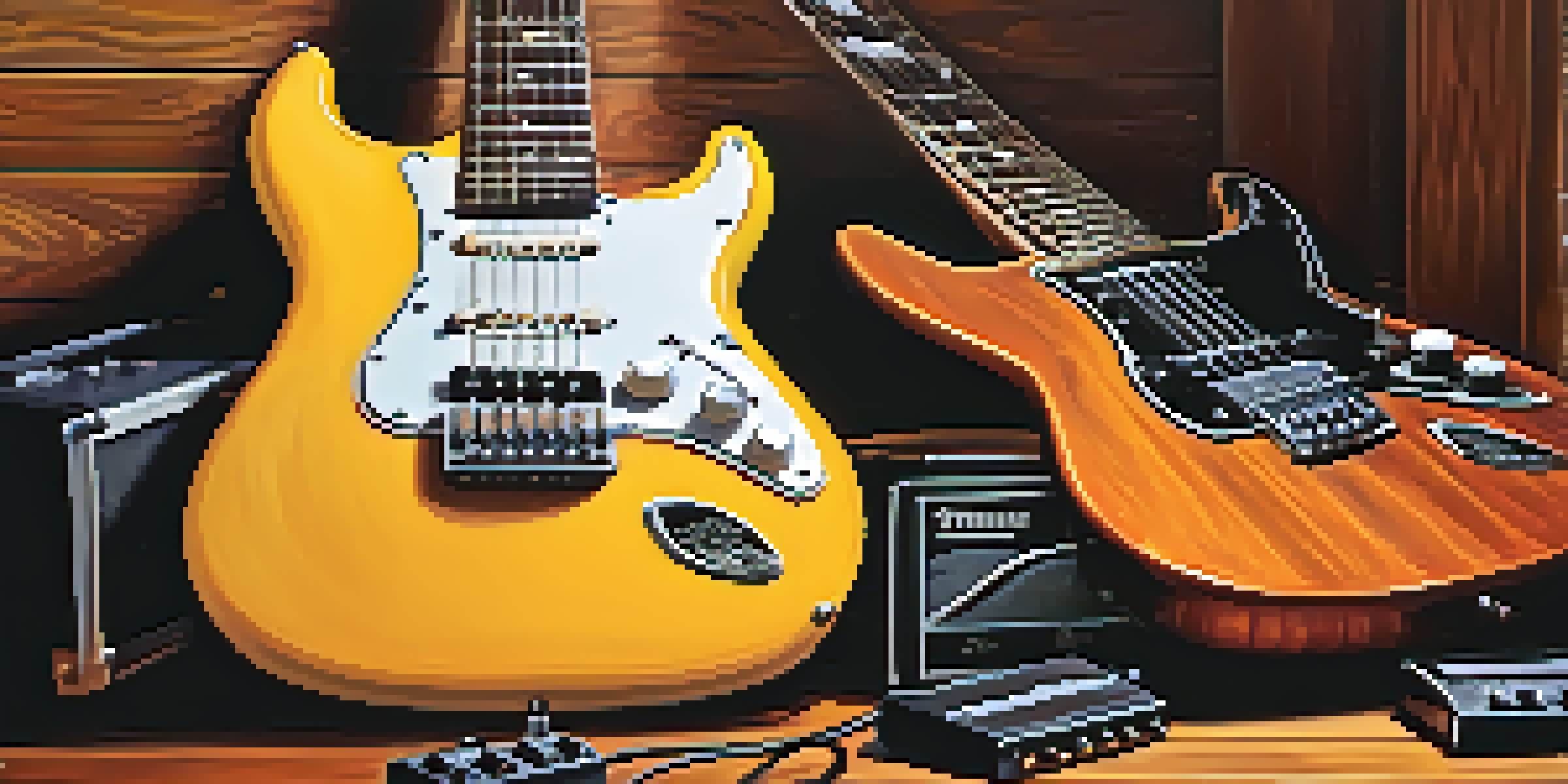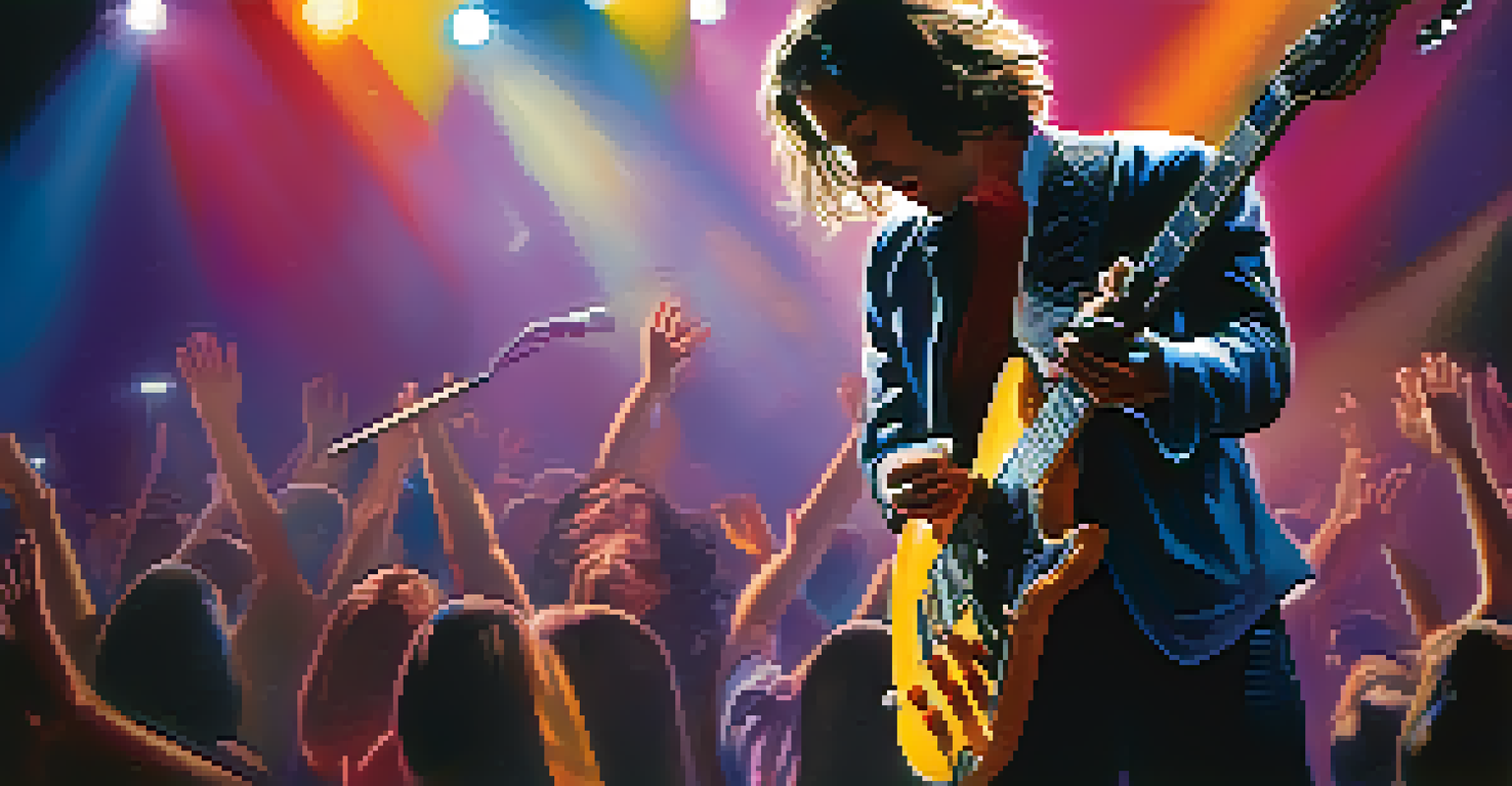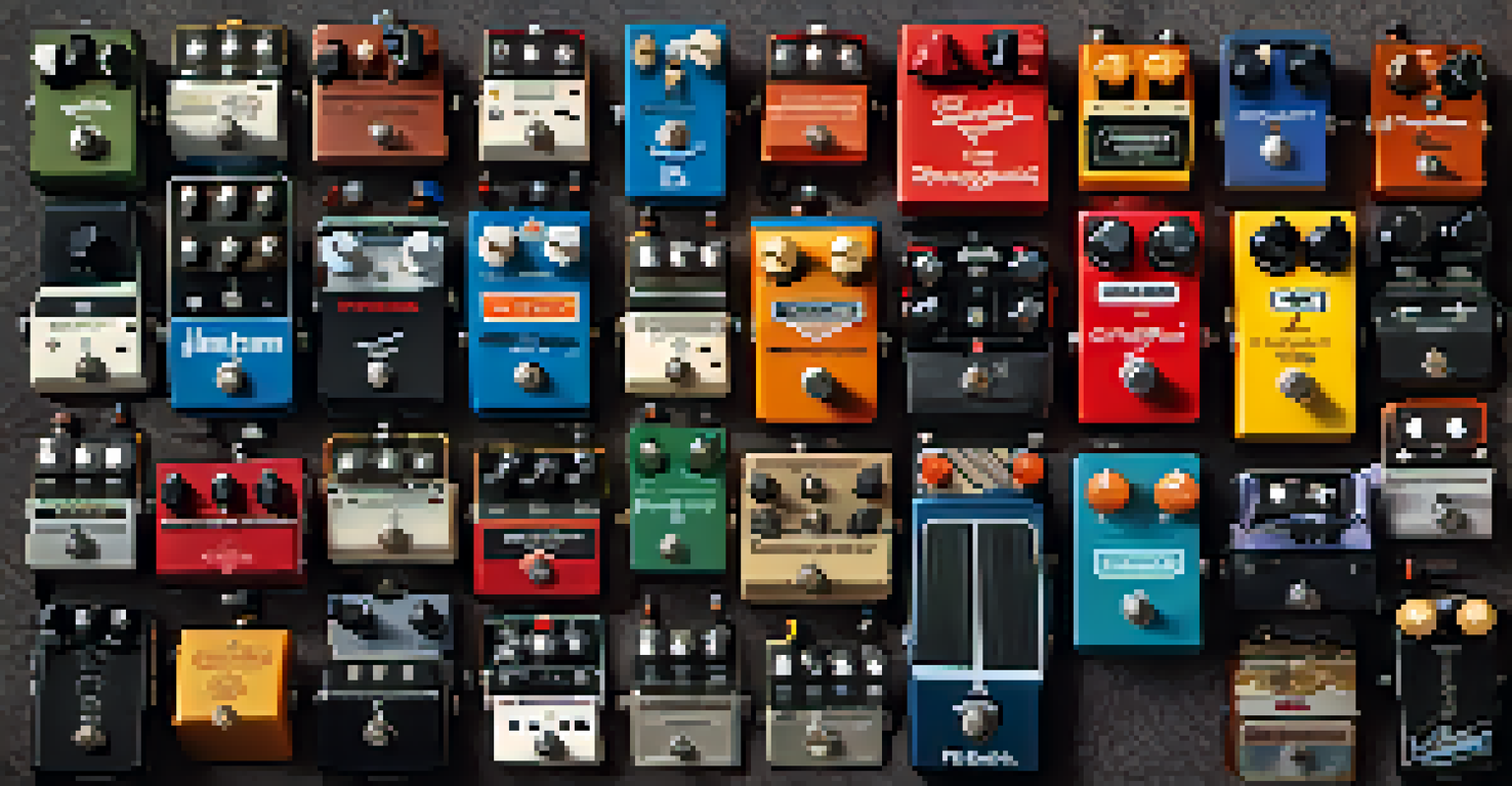Creating Atmosphere with Guitar Effects in Composition

Understanding Guitar Effects and Their Role in Music
Guitar effects are tools that shape and alter the sound of your instrument, adding depth and texture to your music. They can transform a simple melody into an immersive experience, allowing you to create moods that resonate with listeners. Think of effects like reverb and delay as the paintbrushes an artist uses to fill in the canvas of a song.
Music is the shorthand of emotion.
These effects can range from subtle enhancements to dramatic shifts in tone, each contributing uniquely to the overall atmosphere. For instance, a clean guitar sound can evoke clarity and brightness, while a heavily distorted tone might bring out aggression or raw emotion. Understanding how to use these tools effectively is key to crafting compelling compositions.
As you explore different effects, remember that each one serves a specific purpose. Experimenting with various combinations can help you find the right sound that aligns with your creative vision, making your compositions not only sonically interesting but also emotionally impactful.
Creating Mood with Reverb and Delay Effects
Reverb and delay are two of the most popular effects for establishing atmosphere in music. Reverb simulates the natural echo of sound in different environments, from a small room to a vast cathedral, instantly adding depth. Imagine strumming a chord and hearing it resonate as if you were in an expansive space—this effect can transport listeners to another world.

Delay, on the other hand, repeats the sound at set intervals, creating a sense of space and movement. When used creatively, it can make a guitar riff feel like it’s bouncing around the room. For instance, a simple phrase played with a delay can evolve into a lush soundscape, captivating your audience's attention.
Guitar Effects Enhance Sound
Guitar effects like reverb, delay, and distortion add depth and emotion to music, transforming simple melodies into immersive experiences.
When combined, reverb and delay can enhance the emotional weight of a composition. By carefully adjusting the levels and timing, you can craft rich textures that evoke feelings ranging from nostalgia to euphoria, making your music feel more alive and expressive.
Enhancing Emotion with Distortion and Overdrive
Distortion and overdrive add grit and intensity to your guitar sound, making them powerful tools for conveying emotion. These effects can turn clean notes into roaring chords that grab your listener's attention. Just think about the difference between a smooth, clear sound and one packed with raw energy—it’s like shifting from a calm conversation to an impassioned speech.
The guitar is a miniature orchestra in itself.
Distortion can evoke feelings of anger or excitement, while overdrive often brings a warmer, more soulful tone. Artists like Jimi Hendrix and Eric Clapton have mastered these effects to express a wide range of emotions through their guitar work. By incorporating these elements into your compositions, you can tap into the emotional core of your music.
However, it’s essential to use distortion and overdrive judiciously; too much can overwhelm the mix. Finding the right balance will ensure that these effects enhance rather than overshadow your musical ideas, allowing your compositions to resonate deeply with your audience.
Crafting Unique Sounds with Modulation Effects
Modulation effects like chorus, flanger, and phaser can add a unique character to your guitar sound. These effects create movement and complexity by altering the pitch and timing of the signal, making your playing feel more dynamic. Imagine a gentle wave washing over your melody, bringing it to life with subtle shifts and undulations.
Chorus, for example, thickens your sound by layering slightly detuned copies of your signal, creating a lush, shimmering effect. Flanger and phaser introduce a swirling quality that can evoke a sense of space and depth. Using these effects thoughtfully can elevate your compositions, making them stand out with distinctive sonic signatures.
Experimentation Leads to Unique Sound
Mixing different effects and experimenting with combinations can uncover distinctive sounds that reflect your artistic voice.
Experimenting with modulation effects can lead to unexpected and delightful results. By adjusting parameters like depth and rate, you can tailor the sound to fit the mood you're aiming for, whether it's dreamy and ethereal or punchy and energetic.
Using Filters to Shape Your Guitar's Tone
Filters, such as wah and low-pass filters, can dramatically shape your guitar's tone and add an expressive quality to your playing. A wah pedal, for instance, can create a vocal-like quality that adds emotion and personality to your solos. It’s like having a conversation where the guitar speaks with a unique voice, drawing listeners in with its expressiveness.
Low-pass filters allow you to cut out higher frequencies, giving your sound a warmer, more rounded character. This can be particularly effective in creating a vintage or mellow vibe, perfect for genres like jazz or blues. By adjusting the filter settings, you can craft a sound that perfectly complements the mood of your composition.
Integrating filters into your effects chain can help you develop a signature sound. As you explore how different filters interact with other effects, you’ll discover new textures that enhance your musical storytelling.
The Role of Dynamics in Guitar Effects Application
Dynamics play a crucial role in how your effects are perceived within a composition. The way you play—softly or aggressively—can influence how effects like compression, reverb, and distortion react. For example, playing softly with a heavy reverb can create an intimate atmosphere, while aggressive playing can result in a more powerful, impactful sound.
Understanding dynamics allows you to use effects intentionally, guiding the listener's emotional journey throughout your piece. By varying your playing style, you can create contrasts that keep your audience engaged, evoking different feelings at different moments. It’s a powerful way to tell a story through music.
Balance Is Key in Mixing Effects
Maintaining clarity and balance in your mix ensures that guitar effects enhance the composition without overpowering its core elements.
Incorporating dynamic shifts into your performance can transform a good composition into a great one. By paying attention to how your effects interact with your playing dynamics, you can craft a more compelling and immersive experience for your listeners.
Balancing Effects in Your Mix for Clarity
While effects can enhance your guitar's atmosphere, it’s crucial to balance them within the mix. Overusing effects can muddy your sound, making it difficult for listeners to distinguish the core elements of your composition. Think of your mix as a painting—each color (or effect) should complement the others without overwhelming the canvas.
To achieve clarity, consider the frequencies each effect occupies and how they interact with other instruments. Using EQ can help carve out space for your guitar effects, ensuring they enhance rather than compete with other elements of your track. This thoughtful approach can lead to a more polished and professional sound.

Ultimately, balancing your effects is about serving the song. By maintaining clarity and cohesion in your mix, you allow your guitar’s atmosphere to shine through, creating a captivating listening experience that resonates with your audience.
Experimenting with Effects to Find Your Unique Sound
The beauty of guitar effects lies in their endless possibilities for experimentation. Don’t be afraid to mix and match different effects to see what unique sounds you can create. Sometimes, the most unexpected combinations lead to innovative results that become a signature part of your style.
For instance, pairing a reverb with a distortion can yield a lush, expansive sound that feels both powerful and atmospheric. Similarly, layering modulation effects can create a rich texture that transforms a basic riff into something extraordinary. The key is to stay curious and open-minded as you explore different combinations.
As you experiment, keep track of what works and what doesn’t. Over time, you’ll develop a personal palette of sounds and effects that reflect your artistic voice, making your compositions not only distinctive but also deeply personal.